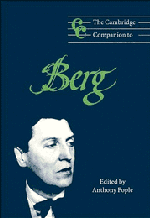Book contents
- Frontmatter
- Introduction
- Part 1 Culture and environment
- Part 2 From song to opera
- Part 3 After Wozzeck
- 8 Secret programmes
- 9 Compositional process in Wozzeck and Lulu: a glimpse of Berg's atonal method
- 10 Compositional technique 1923–6: the Chamber Concerto and the Lyric Suite
- 11 In the orbit of Lulu: the late works
- 12 Lulu's feminine performance
- Part 4 Postscript
- Notes
- Select bibliography
- Index
11 - In the orbit of Lulu: the late works
from Part 3 - After Wozzeck
Published online by Cambridge University Press: 28 September 2011
- Frontmatter
- Introduction
- Part 1 Culture and environment
- Part 2 From song to opera
- Part 3 After Wozzeck
- 8 Secret programmes
- 9 Compositional process in Wozzeck and Lulu: a glimpse of Berg's atonal method
- 10 Compositional technique 1923–6: the Chamber Concerto and the Lyric Suite
- 11 In the orbit of Lulu: the late works
- 12 Lulu's feminine performance
- Part 4 Postscript
- Notes
- Select bibliography
- Index
Summary
An opera and its satellites
Work on his second opera dominated the last eight years or more of Berg's life. Yet he accomplished much else besides. To this period also belongs his Violin Concerto – the earliest serial composition to gain the status of a modern classic – together with the concert aria Der Wein. Berg also compiled and orchestrated his set of Seven Early Songsy prepared a string orchestra version of three movements from the Lyric Suite, revised the Three Orchestral Pieces Op. 6 into the form in which they are generally heard, and produced the set of five symphonic pieces known today as the Lulu Suite; he also published several articles and carried out some smaller compositional tasks, such as the four-voice canon which he dedicated to the Frankfurt opera house. Most of these projects were touched to a lesser or greater degree by their chronological proximity to the composition of Lulu, and in turn the opera bears traces of some of the smaller projects.
Berg began his search for a new operatic subject within a month of the Wozzeck premiere, and following a suggestion from his friend Soma Morgenstern he began to consider the ‘glassworks fairy-tale’ Und Pippa tanzt! (1906) by Gerhart Hauptmann (1862–1946). He wrote to Hauptmann's publishers as early as 8 June 1926 about the matter of a royalty agreement, but pending these negotiations he also gave consideration to the two Lulu tragedies of Frank Wedekind (1864–1918) – responding after more than twenty years to the enormous impression that had been made on him as a young man by his literary idol Karl Kraus's private production of the second Lulu play, Die Büchse der Pandora, in May 1905. Nor were these the only sources he looked at; but by mid-1927 it seemed that Pippa and Lulu were the only serious possibilities.
- Type
- Chapter
- Information
- The Cambridge Companion to Berg , pp. 204 - 226Publisher: Cambridge University PressPrint publication year: 1997
- 1
- Cited by

